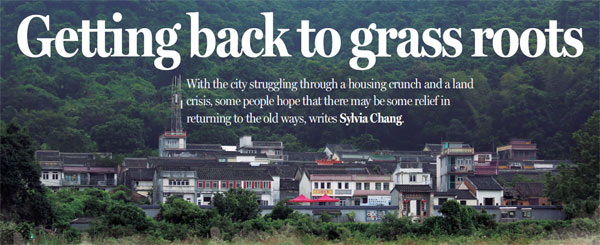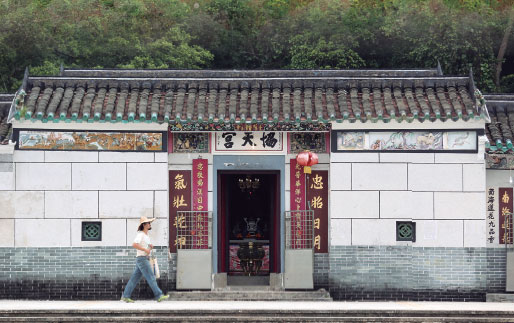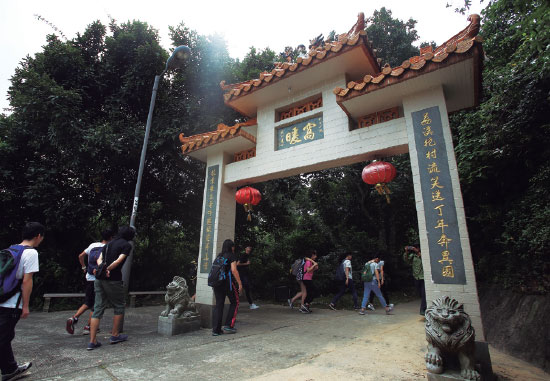Getting back to grass roots
Updated: 2016-11-15 07:23
By Sylvia Chang(HK Edition)
|
|||||||

|
A Hakka-style temple at the public square of Lai Chi Wo. Photos by Parker Zheng / China Daily |
|
The reviving village has attracted tour groups and people from universities to make field trips there. |

With the city struggling through a housing crunch and a land crisis, some people hope that there may be some relief in returning to the old ways, writes Sylvia Chang.
The city is going through a transition amid difficult times: generational conflicts, the festering sore of the wealth gap, and the affordable housing crisis. The malaise engulfs even those aspiring to return to a simpler, more Arcadian life, in full retreat from the insanity of city life. Even the last of the rural farmers have grown suspicious about what these urban conservationists really have in mind.
Lai Chi Wo, an ancient village in northeastern New Territories, is going through a transformation of its own. The village, which became almost a ghost town at one point, now offers hope of reconciliation among the city's clamoring interests and has become a prototype of dozens of other deserted villages for revival.
"This is my home, the place where I feel the most comfortable," said 66-year-old Tsang Shan-wah, gazing out at the nearly 400-year-old Hakka village. His family roots go deep. His ancestors built their first home here in 1642.
Lai Chi Wo, nestled in Plover Cove Country Park at its peak, once boasted a population of about 1,000. The young people fled in a steady exodus about three decades ago. Many of the descendants of the Tsangs and the Wongs, the two Hakka clans who originally settled in the place, joined the global diaspora of Chinese people. Today, having gone full circle, Lai Chi Wo now represents hope for the future.
Tsang Shan-wah was among the young people who left to seek their fortunes elsewhere. He recalled his life before he was called home to close the circle, which carried him to the UK, where he spent 45 years, opened his own restaurants and raised two children in the UK, who have their own lives and careers there.
But he never abandoned his Hakka ways and his taste for salty food. Most of his friends are Hakka people. No matter how long he stayed in Britain, he felt like an outsider. He decided to come home to the place of his birth in 2011. He remains the only Hakka to have resettled in Lai Chi Wo.
The village sits looking out to sea, adjacent to feng shui woodlands at the foot of a mountain. The community's original inhabitants designed their community following the principles of feng shui. The facades of the front row of houses have been restored with traditional Chinese house-building techniques and local materials comprised of sand, mud, rice straw and oyster shells. The old dwellings now serve as education and research facilities, or as centers for community gatherings and heritage exhibitions.
There are about 210 Hakka-style houses, including three ancestral halls, spread over about 90 hectares. Dozens of former residents have come from near and far. Since the "Sustainable Lai Chi Wo" project was inaugurated in 2013, many come to help with the village revival.
Just a few miles away from the village is a slice of farmland nourished by freshwater wetlands. Bursting with an array of organic vegetables, the productivity of the land is being restored after being abandoned for many years until it became overgrown with shrubs. The intent is to help restore the farming community and to promote organic farming. This year Lai Chi Wo was among the Best Tourist Sites in Asia listed by Lonely Planet.
Ancestral longing
"You should not go there (Lai Chi Wo) unless you are well prepared. It is a bug. It is a virus. It will influence you. It will go into your blood and change your DNA. You will fall in love with this place, and you will waste the rest of your life on this site," exalted Lam Chiu-ying, one of the champions working for the revitalization of Lai Chi Wo. His comments, during his opening address to a forum about rural heritage conservation in October, drew appreciative laughter from his audience.
Lam is the former director of the Hong Kong Observatory and current chairman of the Hong Kong Countryside Foundation. In the past three years, he has coordinated with academics at the University of Hong Kong (HKU) and a number of non-governmental organizations to support the sustainable development of Lai Chi Wo.
A respected conservationist, Lam told China Daily that his belief in sustaining Lai Chi Wo is meant to "revive the relationship between the land and the people. This is to enhance the pride and the sense of belonging of Hakka descendants and to maintain a self-sustaining economy in the village".
"People who have a sense of township can paint a picture of the town in their minds. This township is the source of security that helps to build mutual trust among people," Lam said. A city dweller himself, Lam felt gratified to see heirs of the original Hakka inhabitants returning to their origins. This, he said, is his true motive.
Lai Chi Wo is unique in its strong bonds among the villagers. The village, in the center of Sha Tau Kok town, is a gathering point for seven nearby villages. Children from other villages attended primary school here. The school had about 300 children in its prime.
"Although most villagers emigrated overseas, they gather every August in the UK. Hundreds of villagers show up on that day," said Tsang Wai-yip, village representative of Lai Chi Wo and the 14th generation of Tsangs.
At the gatherings, former schoolmates and childhood playmates share their nostalgic memories. "They discuss rehabilitating their ancestral homes back in Lai Chi Wo," Tsang Wai-yip said. Some households with the economic means did come back to take care of their houses.
Still, most houses had become ramshackle and overgrown with shrubs, layers of lichens and weeds. At the beginning, when Lam and his team started talking to villagers about the revitalization, most villagers were doubtful about their intentions.
"People in the New Territories have always had a strong bias against conservationists, like Mr Lam," Tsang Wai-yip confessed. "There was a conspiracy theory spread among villagers. 'Watch out,' they warned each other."
Lam echoed that the "Sustainable Lai Chi Wo" project encountered plenty of contradictions.
"At the beginning, villagers thought that we were going to seize their deserted farmlands over 'environmental protection issues' - to allow trees to grow freely.
"When we began to hack away the grass and shrubs, we had to persuade the green groups that we were not going to damage the environment, but to restore nature-friendly agriculture, to reach dynamic equilibrium between the field and its surroundings," said Lam, explaining that ecological surveys have been conducted in the process to preserve biodiversity.
Pilot scheme
Including Lai Chi Wo, Hong Kong has 77 sections of privately owned land nestled inside country parks. Known as country park enclaves, they cover about 2,000 hectares in total. Several of them have become deserted and undergone ecological destruction due to exclusion from country park boundaries. There have been rising tensions between the competing pressures for development and conservation.
Most of the landowners are indigenous villagers whose ancestors settled in the area which became the New Territories after the British signed the land lease in 1898. A privilege granted to indigenous villagers allows each male descendent to build a three-story, 700-square-foot house in the rural area.
The policy has been the source of controversy for many years, owing to Hong Kong's notoriously limited land supply and population growth. Many of the enclaves were reportedly sold to private developers who can convert the land and build luxury villas.
The massive sell-off never happened in Lai Chi Wo, the villagers say. The preliminary achievements in restoring sustainable development to the village have earned high praise from the Heung Yee Kuk (HYK), the government-sanctioned advisory body representing the interests of indigenous villagers in the New Territories.
"Lai Chi Wo is a very good pilot scheme for village revitalization, as it maintains the balance between development and heritage preservation. We would like to revive other villages in a similar way," said Kenneth Lau Ip-keung, chairman of the HYK and lawmaker for the HYK functional constituency.
Lau considers revitalization of abandoned villages one of the most important initiatives of his tenure. He wants the HYK to "serve as a bridge between indigenous villagers, green groups and the government".
"The kuk has the trust of indigenous villagers. However, while considering their interests, we want the whole of society to benefit," Lau said.
Lau is considering setting up a design contest based on rural architecture. Although plans are only preliminary at this point, Lau foresees "win-win cooperation between villagers and conservation groups".
Kuk Po, Fang Hang, So Lo Pun and Sha Lo Tung are among the other villages where Hakka-style houses remain which could implement renewal plans.
Of 800,000 indigenous villagers, about 100,000 of nearly 300,000 who live overseas are willing to return, Lau estimates. Most were born in the 1950s and 1960s.
Lau said the HYK is open to other ideas for village revival. He welcomes submissions from conservation groups and university students studying design and architecture. Lau also expects the government to support the communities with basic facilities including water, electricity and transport.
"In some ways, the history of Hong Kong is the history of the New Territories. Many villages wore out and became deserted. If we don't revive them, their history will soon disappear," Lau said, urging more villagers to get involved so their origins are not buried by time.
Contact the writer at sylvia@chinadailyhk.com

(HK Edition 11/15/2016 page10)

